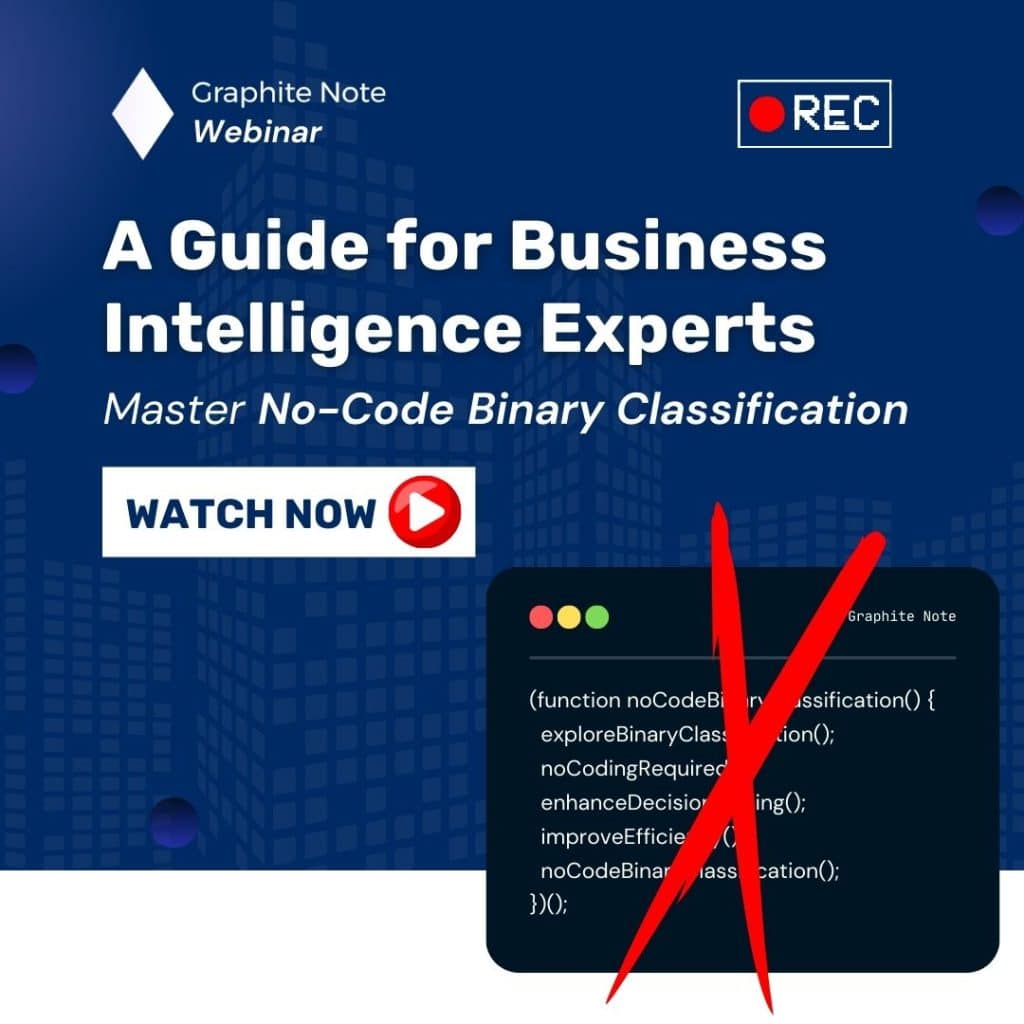Binary classification is a fundamental task in machine learning. Binary classification problems involve categorizing instances into one of two classes, typically represented as 0 and 1, each a binary classifier. The outcome is known as a binary outcome. A binary classification problem solving method is used to solve binary classification problems where the outcome falls into one of two categories. Binary classification is a one of the types of classification algorithms. There are also multiclass classification, class classification, neural network, regression model, naive bayes, and more. You don’t need a team of data scientists to use binary classification in machine learning to enhance your business. Machine learning models can be implemented using no-code machine learning tools like Graphite Note. Binary classification examples include determining whether an email is spam or not, predicting customer churn, or classifying images as cats or dogs.
Key Components of Binary Classification Models
- Feature Variables: Feature variables, or input variables, are the attributes of instances fed into the machine learning model. These can include a data set that encompasses numerical values, categorical data, or a mix of both. The quality of these variables greatly influences the model’s performance. Feature variables can also be considered training data. The quality of your training data sets affect the outcomes and accuracy score your machine learning model will produce. For example, in a binary classification model predicting spam emails, features might include email length, presence of certain keywords, and the sender’s address.
- Target Variables: Target variables, or labels, are the classes we want to predict. In binary classification, each instance belongs to one of two classes. For example, the target variable for spam detection would be whether an email is spam (1) or not spam (0). Your target variables could be considered the results of your machine learning model’s training and statistical analysis. The better quality data you input, the better your results will be, especially when applied to new data. If you find your test result to contain many false positives or false negatives, you may need to reassess your feature variables. Avoiding a high positive rate and a high negative rate is key, as these ensure a good test result. An accurate test result is imperative for being able to interpret the insights your machine learning model provides. With deep learning, it’s important to monitor your true positive rate and your false positive rate. A false negative can throw off your results. True positives and true negatives are metrics to measure, as these give you the assurance that you’re getting the right results.
Types of Binary Classification Models
Logistic Regression
Logistic regression is a popular algorithm for binary classification. Logistic regression models the relationship between input features and the probability of belonging to a specific class using a logistic function. This activation function maps any input to a value between 0 and 1, interpreted as the probability of the positive class.
Decision Trees
Decision trees partition the feature space into regions based on rules derived from feature variables. Each region corresponds to a specific class, making this approach interpretable and powerful. Decision trees also enable you to apply feature importance analysis.
Support Vector Machines
Support Vector Machines (SVMs) create hyperplanes to separate instances of different classes. A support vector machine aims to maximize the margin between the hyperplane and the closest instances, providing robust classification boundaries.
Building a Binary Classification Model
- Data Preparation: Preparing and preprocessing data is essential before training a binary classification model. This includes handling missing values, encoding categorical variables, and scaling numerical features. Proper data preparation ensures the model receives clean and consistent input. Effective deep learning requires clean, well prepared data. This way you can be sure of true negatives, and not a false negative.
- Model Training: Training involves feeding the feature variables and corresponding labels into an algorithm. The model learns the relationship between them and optimizes its parameters to minimize prediction errors.
- Model Evaluation: Evaluating your machine learning model’s performance is important. This is done using metrics like accuracy, precision, recall, and F1 score on a separate dataset not used during training. These metrics help you evaluate how well the model generalizes to unseen data.
Improving Binary Classification Models
- Feature Selection Techniques: Not all feature variables contribute equally to the task. Feature selection helps identify the most relevant features, reducing dimensionality and improving performance.
- Handling Imbalanced Data: Imbalanced data can bias models toward the majority class. Techniques like oversampling the minority class, undersampling the majority class, or using algorithms like SMOTE can address this issue.
- Hyperparameter Tuning: Hyperparameters are parameters not learned during training but affect the model’s behavior. Tuning these can optimize performance. Techniques like grid search or random search can find the best hyperparameters for a given model and dataset.
Practical Applications for Binary Classification in Machine Learning
Binary classification models are used in various real-world applications. These include sentiment analysis, fraud detection, disease diagnosis, and customer churn prediction. Understanding the basics and key components of these models helps build robust solutions for specific classification tasks.
Conclusion
Binary classification models are powerful tools in machine learning. They enable categorization of instances into two classes, driving effective decision-making. Follow best practices in data preparation and employ techniques to enhance performance, to ensure you can make accurate predictions and benefit from valuable insights. Ready to take the next step in binary classification and predictive analytics? Graphite Note empowers your team, regardless of their AI expertise. Our no-code platform transforms complex data into actionable insights and precise business outcomes with just a few clicks. Whether you’re in marketing, sales, operations, or data analysis, Graphite Note’s tools unlock efficiency and enhance decision-making. Request a demo today.




![A Comprehensive AI and Machine Learning Glossary of 100+ Key Terms [A-Z]](https://graphite-note.com/wp-content/uploads/2023/01/Blog-banners-2-1024x576.jpg)
